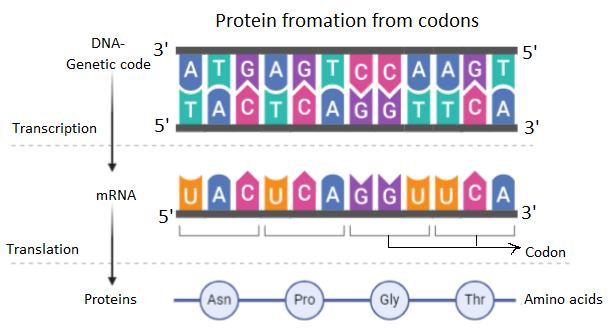
Which one of the following codons codes for the same information as UGG?
A. UGU
B. UGA
C. UAG
D. UGG
Answer
552.3k+ views
Hint:Codons are the genetic codes consisting of three base pairs. Thus, they are called triplet codons. These are the amino acid translating units of the genetic material. The translation machinery reads a codon specific to an amino acid and translates the codon sequence to make proteins. UGG codes for tryptophan. Except for tryptophan and methionine, all other amino acids are coded by several codons.
Complete answer:The genetic code lying inside the nucleus of the cells is a sequence of nucleotides in the form of DNA or Deoxyribonucleic acid. The sequence holds the codes that determine the amino acid sequence of proteins. The information contained in DNA is needed to go through a series of steps that occur for the formation of proteins. These steps are transcription and translation. In transcription, an mRNA transcript is made which holds the information for protein synthesis. This sequence consists of codons. Codons are useful sequences of DNA made of three nucleotide base pairs that can code for particular amino acids. Our body is capable of producing 20 amino acids. For these 20 amino acids, 64 codons are present.

For methionine and tryptophan amino acids there is only a single codon present for them individually. All of the other amino acids have several codons that code for them. UGG codes for tryptophan and hence there are no similar codons to UGG that can code for tryptophan. UGG itself is the codon specific to tryptophan. UGU codes for cysteine amino acids. UGA and UAG are codons for termination of the protein synthesis process and they do not code for any amino acids.
Therefore, from the above discussion, we can conclude that option D is the correct answer.
Note: It is controversial to know that methionine and tryptophan have only one codon for them to get translated. Methionine is a start codon and thus initiates the translation process and is coded by AUG. too many start codons may lead to interrupted coding of amino acids. But tryptophan is a polypeptide and used as a building block. Hence, the singularity for its codon is not understandable.
Complete answer:The genetic code lying inside the nucleus of the cells is a sequence of nucleotides in the form of DNA or Deoxyribonucleic acid. The sequence holds the codes that determine the amino acid sequence of proteins. The information contained in DNA is needed to go through a series of steps that occur for the formation of proteins. These steps are transcription and translation. In transcription, an mRNA transcript is made which holds the information for protein synthesis. This sequence consists of codons. Codons are useful sequences of DNA made of three nucleotide base pairs that can code for particular amino acids. Our body is capable of producing 20 amino acids. For these 20 amino acids, 64 codons are present.

For methionine and tryptophan amino acids there is only a single codon present for them individually. All of the other amino acids have several codons that code for them. UGG codes for tryptophan and hence there are no similar codons to UGG that can code for tryptophan. UGG itself is the codon specific to tryptophan. UGU codes for cysteine amino acids. UGA and UAG are codons for termination of the protein synthesis process and they do not code for any amino acids.
Therefore, from the above discussion, we can conclude that option D is the correct answer.
Note: It is controversial to know that methionine and tryptophan have only one codon for them to get translated. Methionine is a start codon and thus initiates the translation process and is coded by AUG. too many start codons may lead to interrupted coding of amino acids. But tryptophan is a polypeptide and used as a building block. Hence, the singularity for its codon is not understandable.
Recently Updated Pages
Master Class 12 English: Engaging Questions & Answers for Success

Master Class 12 Business Studies: Engaging Questions & Answers for Success

Master Class 12 Economics: Engaging Questions & Answers for Success

Master Class 12 Social Science: Engaging Questions & Answers for Success

Master Class 12 Maths: Engaging Questions & Answers for Success

Master Class 12 Chemistry: Engaging Questions & Answers for Success

Trending doubts
What are the major means of transport Explain each class 12 social science CBSE

Which are the Top 10 Largest Countries of the World?

Draw a labelled sketch of the human eye class 12 physics CBSE

Explain sex determination in humans with line diag class 12 biology CBSE

The pH of the pancreatic juice is A 64 B 86 C 120 D class 12 biology CBSE

Explain sex determination in humans with the help of class 12 biology CBSE




